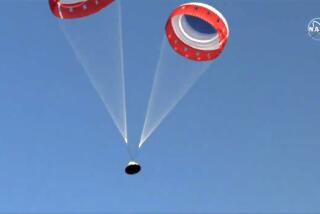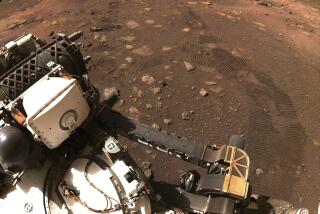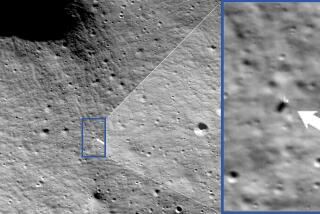JPL’s Curiosity mission comes down to this: the Martian surface
- Share via
Three weeks from tonight, an amiable, whip-smart engineer named Ray Baker will be staring into his computer screen at the Jet Propulsion Laboratory, hopeful and helpless — or, as he puts it, “sweating blood.”
The night will have been 10 years and $2.5 billion in the making, incorporating the work of 5,000 people in 37 states. And then, 154 million miles from home, the fate of the most ambitious machine humans have sent to another planet will rest on a seven-minute landing sequence so far-fetched it looks like something Wile E. Coyote devised to catch the Road Runner.
After a journey of nearly nine months, the six-wheel laboratory NASA has dubbed Curiosity is scheduled to touch down on Mars at 10:31 p.m. PDT on Aug. 5.
INTERACTIVE: From liftoff to landing
Curiosity’s science could captivate the public like no other space mission in recent memory. The robot is equipped with a nuclear-powered lab capable of vaporizing rocks and ingesting soil, furthering the search for signs of life, revolutionizing the study of Mars and potentially paving the way for human exploration.
Initially, though, the allure of the mission will come in its daredevil landing on the floor of a crater. In the time it takes to drive to the grocery store, the spacecraft will change shape like a toy Transformer six times, slowing from 13,000 mph to 1.7 mph while using 76 pyrotechnic devices, ropes, knives and the largest supersonic parachute ever built.
“When you work through the engineering, it actually makes a lot of sense,” said Baker, who has been an engineer since 2001 at La Cañada Flintridge’s Jet Propulsion Laboratory, which is managing the mission for NASA. “But it looks crazy.”
PHOTOS: Curiosity’s date with Mars
What’s more, the entire sequence must run on its own, because Mars is so far away that scientists can’t fly the craft remotely; they will have sent their last command to the spacecraft two hours earlier.
Curiosity will send an alert when it enters the Martian atmosphere, but it will take the message roughly 14 minutes to reach Earth. So, by the time the message is received, the craft will have already been on the surface for seven minutes, either intact or wrecked. NASA has labeled this period “seven minutes of terror.”
Mars is a notoriously difficult place to land a machine. “It’s known for eating spacecraft,” said Devin Kipp, another of the 30-odd JPL engineers responsible for Curiosity’s landing sequence.
Beyond the travel involved, Mars’ atmosphere is 100 times thinner than Earth’s — just enough to cause problems but not enough to slow down a spacecraft to a manageable speed without powerful assistance. More than half of missions to Mars, dating to a series of fly-by attempts by the Soviet Union in the 1960s, have failed, and JPL remains the only institution to deposit a successful robot on the Red Planet.
The elaborate landing sequence for Curiosity grew out of necessity. As it was being designed, scientists began ratcheting up their ambitions. That meant new gadgets, which begot more gadgets needed to power and protect them. “The rover started to grow,” Baker said. Before long, the plan called for a 2,000-pound rover the size of a small car — five times heavier than NASA’s previous Mars rovers.
Landing sequences used in the past wouldn’t work. The contraption that in 2004 allowed the Spirit and Opportunity rovers to bounce in an air bag to resting positions became too heavy to launch when scaled up for Curiosity. Engineers initially wanted to land Curiosity on a platform, then pilot it down a ramp. But the platform design grew to unmanageable proportions.
So the engineers came up with something new — a sequence so odd that even some of the scientists tasked with building the thing were highly skeptical.
Curiosity, folded inside a heat shield, will hit the Martian atmosphere at 13,000 mph, firing thrusters to stabilize its course and steer it toward the crater. Atmospheric friction will heat the shield to 1,600 degrees and begin to slow the craft.
When it reaches about 1,000 mph, an explosive charge will release a massive parachute that is packed to the density of wood and capable of withstanding 65,000 pounds of force.
The craft will discard its heat shield, which would otherwise act like a lens cap on a camera — Curiosity’s radar couldn’t “see” the ground to find its target.
In less than two minutes, the spacecraft will slow to about 200 mph. It will then jettison the parachute and, for a brief moment, be in free fall.
“Here’s where it gets really exciting,” Baker said with a laugh.
Eight rocket engines pointed at the ground will erupt, arresting the fall. But the discarded parachute will be falling right behind; Curiosity could stick the landing, only to find itself smothered by the massive chute. So the craft will use the engines to lurch about 350 yards, out of the chute’s path.
The spacecraft will then be about a mile above the ground. In the next 35 seconds, the rockets will slow the craft to less than 2 mph.
In theory, the rockets could provide a gentle enough landing to finish the job. But in practice, they would kick up such a dust storm that it could ruin the rover. So at 66 feet, the rover will fall yet again. As the craft descends, Curiosity will be spat out by a “sky crane,” lowered by 25-foot ropes as the rover unfurls its wheels.
A last critical moment will come when Curiosity’s wheels touch down, because the spacecraft will suddenly lose half its weight. If it begins to drift, the ropes could drag the rover. So Curiosity has 0.7 of a second to fire pyrotechnic charges that send blades sweeping across the nylon tethers. Once the ropes are cut, the craft above — its job completed — will rocket off, crash-landing a safe 450 meters away.
Then, finally, the rover will be alone, and safe, and prepared to begin the mission.
“I’ve been trying to imagine it,” Baker said. “I’m looking forward to seeing what my reaction will be. We’ll be celebrating like mad. We’re down safe. The descent stage is over — and it’s game time for the science team.”
The engineers are spending their final days tinkering with the system to ensure that they are prepared for any problems, such as unusually high winds.
On a recent morning, a dozen engineers gathered at JPL in the same room they’ll be in the night of the landing. They were sending a software patch to the rover as it flew toward Mars, intended to make the craft more impervious to unusual atmospheric conditions.
Inside the room, there was little sound other than the hum of 100 computers and occasional engineer-speak: “Niner Eight Bravo.” “Load the binary.” The file was a mere 190 kilobytes; a desktop computer would load that amount of information in seconds, but because Curiosity was 140 million miles away, it took 29 minutes. Engineers watched the clock warily. One tapped his wristwatch as if he were waiting for a train.
“Just waiting on the speed of light,” Baker said under his breath. “Too slow for us.”
Then, the spacecraft responded — success.
There are few days left to tinker. Before long, engineers will send their last commands and hope for the best. “We talk to the spacecraft every day,” Baker said. “But pretty soon it’s time to just watch it fly.”
Engineers are a superstitious sort — they’ll be eating their traditional peanuts the night of the landing, some wearing their lucky mission shirts — but they’re confident about the landing sequence, most of the time.
In the beginning, “there were a lot of questions,” said Steve Sell, a member of the entry, descent and landing engineering team. A large group, including engineers and astronauts — even pilots who had flown Sikorsky Skycrane heavy-lift helicopters — weighed in with concerns and corrections. By now, after hundreds of tests and fixes, “we’re very comfortable,” Sell said.
“There’s always a little bit of you that thinks there is an ‘unknown unknown,’ and that’s the thing we always fear,” he said. “On landing day, we’ll all be nervous. But I don’t think any of us will be thinking that there was something else we should have done.”
Engineers ran many tests on the parachute, for instance, in a massive wind tunnel. They’re confident the chute will withstand the force needed to slow the craft down. But it was more difficult, because of atmospheric differences, to make sure the chute will inflate the same way above Mars that it did in the tunnel.
“It’s not really possible to do an end-to-end test on Earth — because Earth is not Mars,” Kipp said. “The whole program was based on doing it in pieces, and putting those pieces together will prove that the system will work as a whole. But the first time we do that end-to-end test, it’s not a test. It’s the real thing. On Mars.”







